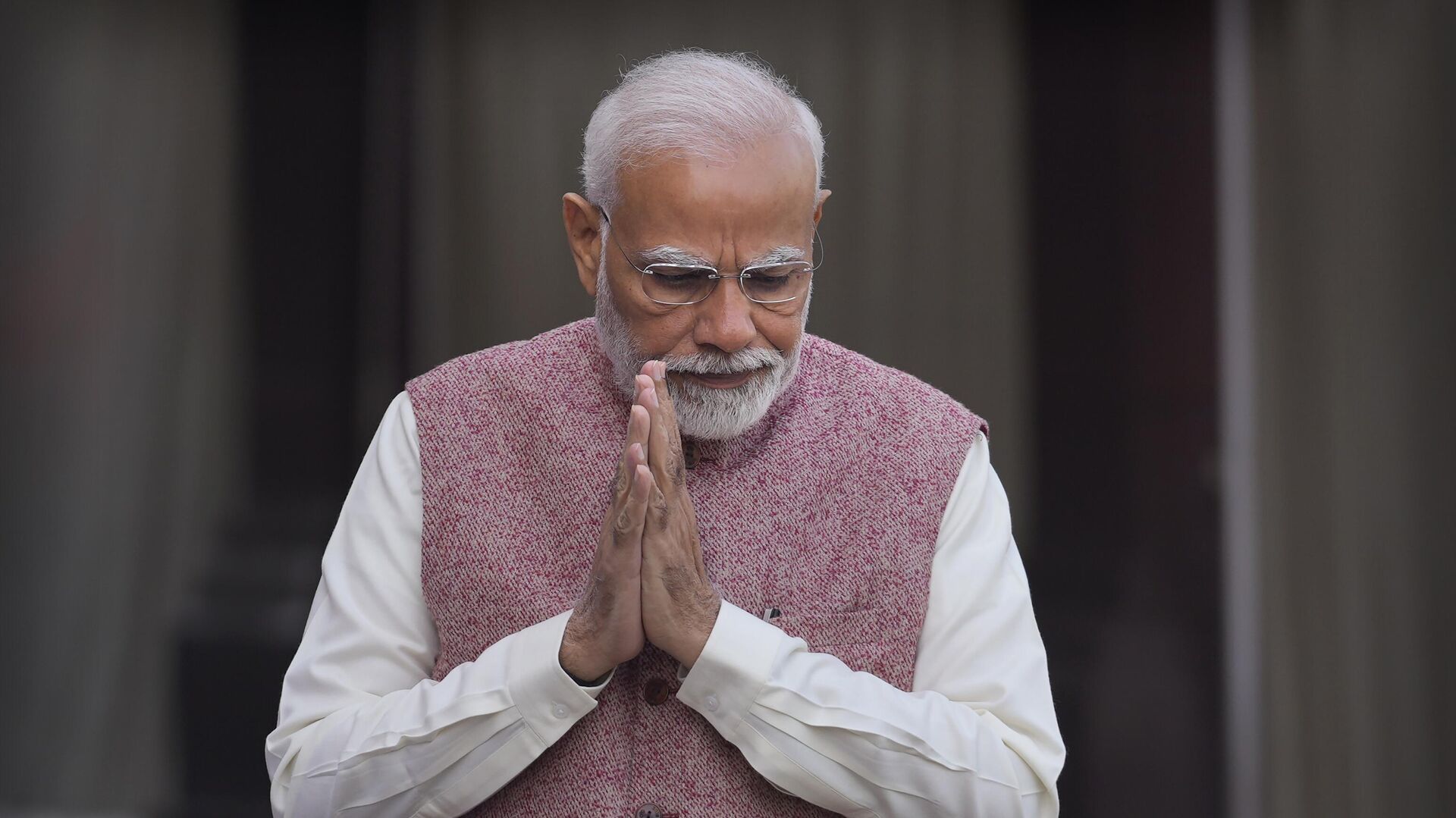https://sputniknews.in/20230317/how-modis-diplomacy-drove-west-to-change-its-posture-vis--vis-india-1214233.html
How Modi’s Diplomacy Drove West to Change Its ‘Posture’ Vis-à-vis India
How Modi’s Diplomacy Drove West to Change Its ‘Posture’ Vis-à-vis India
Sputnik India
Prime Minister Narendra Modi is being hailed as a credible face for peace amid geopolitical tensions between Russia, China and the west in the wake of the... 17.03.2023, Sputnik India
2023-03-17T18:39+0530
2023-03-17T18:39+0530
2023-03-20T18:05+0530
india
narendra modi
russia
ukraine
china
ladakh
border tensions
western sanctions
oil supplies
russian oil price cap
https://cdn1.img.sputniknews.in/img/07e6/0c/19/229182_0:0:3092:1739_1920x0_80_0_0_06d50526c2c480320216b9f8acaa1495.jpg
Prime Minister Narendra Modi’s refusal to be brow-beaten by the western countries on the Ukraine issue has forced the US and its European allies to change their “posture” towards New Delhi, former Indian Ambassador K.P Fabian has told Sputnik.“Initially, the West chose to brow-beat India by putting pressure privately and publicly. India stood up, and not only maintained economic relations, it even enhanced such relations,” noted Fabian, a reference to growing energy and commercial ties between New Delhi and Moscow.For the last five months, Russia has ranked as India’s top crude supplier amid global volatility in energy prices.'Indo-Russian Ties Stand on Their Own Merit'Asoke Kumar Mukherjee, India’s former Permanent Representative to the UN, told Sputnik that India has prioritized a “political settlement through dialogue and diplomacy” to resolve the Ukraine crisis.He said that New Delhi’s ties with Moscow “stand on their own merit and not as an adjunct to India's relations with other countries”.“That is because of the track record of India-Russia relations, which go back several centuries, with the first records of India-Russia interaction available in Afanasii Nikitini's voyage to India in 1469,” he noted.Mukherjee further recalled that Prime Minister Modi and Russian President Vladimir Putin have maintained regular contact at a bilateral level and at multilateral forums such as the UN and the Shanghai Cooperation Organization (SCO).Explaining the strong defence ties between New Delhi and Moscow, Mukherjee said that they are underpinned by the policy of ‘Make in India’, involving the transfer of technology to develop high-tech weapons in India.He cited the Su-30MKI fighter jets and BrahMos missiles as other notable examples of the India-Russia defence partnership.No Room for Western Interference in India-China TiesSimilarly, India’s bilateral relationship with China “stands on its own merit” with no room for interference by any foreign power, ex-Indian Ambassador Ashok Sajjanhar told Sputnik.In 2022, India carried out a bilateral trade of $118 billion with China, making Beijing its second-biggest trading partner after the US Bilateral trade between the two Asian powerhouses touched a record $100 billion-mark for the first time in 2021.Sajjanhar underscored inspite a growing momentum in India-US strategic ties and, at the same time, a deteriorating relationship between Washington and Beijing, New Delhi won’t allow Washington to influence its policy towards Beijing.He further noted that although New Delhi has been one of the four countries comprising the Quad grouping, Prime Minister Modi has maintained that it is a forum for “global good”.Progress on Resolving Ladakh StandoffHowever, Sajjanhar noted that New Delhi’s overall relationship with Beijing has been affected because of the ongoing military standoff in the eastern Ladakh region, which began in 2020.He noted that New Delhi has accused Beijing of violating the five border protocols of 1993, 1996, 2005, 2005, and 2012. The relevant protocols are meant to keep the border differences from escalating into a conflict-like situation.New Delhi has maintained that the state of the border will reflect the state of overall bilateral relationship.During a meeting between visiting Chinese Foreign Minister Qin Gang and Indian Foreign Minister S. Jaishankar on the sidelines of the G20 Foreign Ministers’ Meeting (FMM) this month, the Indian host told his Chinese guest that bilateral ties continue to remain “abnormal”.Over 60,000 Indian and Chinese troops continue to remain engaged in Demchok and Depsang sectors, the last remaining friction points.Sajjanhar, however, noted that considerable progress has been achieved in de-escalating the border situation, with the two armies having disengaged troops from the northern and southern banks of Pangong Tso Lake and the Gogra Hot Springs area.
https://sputniknews.in/20230316/russia-may-continue-supporting-indias-nuclear-sub-program-says-navy-veteran-1177270.html
https://sputniknews.in/20230317/indian-army-chief-hopeful-of-resolving-ladakh-standoff-through-diplomacy-1205798.html
india
russia
ukraine
china
ladakh
Sputnik India
feedback.hindi@sputniknews.com
+74956456601
MIA „Rossiya Segodnya“
2023
Dhairya Maheshwari
https://cdn1.img.sputniknews.in/img/07e6/0c/13/138962_0:0:641:640_100x100_80_0_0_2cb44360dbcdf6d84bf4b299cd045917.jpg
Dhairya Maheshwari
https://cdn1.img.sputniknews.in/img/07e6/0c/13/138962_0:0:641:640_100x100_80_0_0_2cb44360dbcdf6d84bf4b299cd045917.jpg
News
en_IN
Sputnik India
feedback.hindi@sputniknews.com
+74956456601
MIA „Rossiya Segodnya“
Sputnik India
feedback.hindi@sputniknews.com
+74956456601
MIA „Rossiya Segodnya“
Dhairya Maheshwari
https://cdn1.img.sputniknews.in/img/07e6/0c/13/138962_0:0:641:640_100x100_80_0_0_2cb44360dbcdf6d84bf4b299cd045917.jpg
ukraine news, ukraine russia news, modi news, modi nobel prize, india russia relations, india russia news, india russia trade, india russia oil, india china news, india war, india china border
ukraine news, ukraine russia news, modi news, modi nobel prize, india russia relations, india russia news, india russia trade, india russia oil, india china news, india war, india china border
How Modi’s Diplomacy Drove West to Change Its ‘Posture’ Vis-à-vis India
18:39 17.03.2023 (Updated: 18:05 20.03.2023) Prime Minister Narendra Modi is being hailed as a credible face for peace amid geopolitical tensions between Russia, China and the west in the wake of the Ukraine crisis.
Prime Minister Narendra Modi’s refusal to be brow-beaten by the western countries on the Ukraine issue has forced the US and its European allies to change their “posture” towards New Delhi, former Indian Ambassador K.P Fabian has told Sputnik.
“Initially, the West chose to brow-beat India by putting pressure privately and publicly. India stood up, and not only maintained economic relations, it even enhanced such relations,” noted Fabian, a reference to growing energy and commercial ties between New Delhi and Moscow.
For the last five months, Russia has ranked as
India’s top crude supplier amid global volatility in energy prices.
"I have no reason to believe that India is going to change its position. The West has to recognize that India has a right to independent decision-making in foreign policy,” he argued.
'Indo-Russian Ties Stand on Their Own Merit'
Asoke Kumar Mukherjee, India’s former Permanent Representative to the UN, told Sputnik that India has prioritized a “political settlement through dialogue and diplomacy” to resolve the Ukraine crisis.
He said that New Delhi’s ties with Moscow “stand on their own merit and not as an adjunct to India's relations with other countries”.
“That is because of the track record of India-Russia relations, which go back several centuries, with the first records of India-Russia interaction available in Afanasii Nikitini's voyage to India in 1469,” he noted.
Mukherjee further recalled that Prime Minister Modi and Russian President Vladimir Putin have maintained regular contact at a bilateral level and at multilateral forums such as the UN and the Shanghai Cooperation Organization (SCO).
Explaining the strong defence ties between New Delhi and Moscow, Mukherjee said that they are underpinned by the policy of ‘Make in India’, involving the transfer of technology to develop high-tech weapons in India.
He cited the
Su-30MKI fighter jets and
BrahMos missiles as other notable examples of the
India-Russia defence partnership.
No Room for Western Interference in India-China Ties
Similarly, India’s bilateral relationship with China “stands on its own merit” with no room for interference by any foreign power, ex-Indian Ambassador Ashok Sajjanhar told Sputnik.
“China is our neighbor. We share a 3,488-kilometre-long border. China is also one of India’s biggest trading partners. The India-China relations stand on their footing,” Sajjanhar stated.
In 2022, India carried out a bilateral trade of $118 billion with China, making Beijing its second-biggest trading partner after the US Bilateral trade between the two Asian powerhouses touched a record $100 billion-mark for the first time in 2021.
Sajjanhar underscored inspite a growing momentum in India-US strategic ties and, at the same time, a deteriorating relationship between Washington and Beijing, New Delhi won’t allow Washington to influence its policy towards Beijing.
He further noted that although New Delhi has been one of the four countries comprising the Quad grouping, Prime Minister Modi has maintained that it is a forum for “global good”.
Progress on Resolving Ladakh Standoff
However, Sajjanhar noted that New Delhi’s overall relationship with Beijing has been affected because of the ongoing military standoff in the eastern Ladakh region, which began in 2020.
He noted that New Delhi has accused Beijing of violating the five border protocols of 1993, 1996, 2005, 2005, and 2012. The relevant protocols are meant to keep the border differences from escalating into a conflict-like situation.
He maintained: “India never violated the border protocols. It didn’t violate the sanctity of the Line of Actual Control (LAC) (de-factor border between the two countries). Even now, India is advocating for dialogue to resolve the standoff.”
New Delhi has maintained that the state of the border will reflect the state of overall bilateral relationship.
During a meeting between visiting Chinese Foreign Minister Qin Gang and Indian Foreign Minister S. Jaishankar on the sidelines of the G20 Foreign Ministers’ Meeting (FMM) this month, the Indian host told his Chinese guest that bilateral ties continue to remain “abnormal”.
Over 60,000 Indian and Chinese troops continue to remain engaged in Demchok and Depsang sectors, the last remaining friction points.
Sajjanhar, however, noted that considerable progress has been achieved in de-escalating the border situation, with the two armies having disengaged troops from the northern and southern banks of Pangong Tso Lake and the Gogra Hot Springs area.




